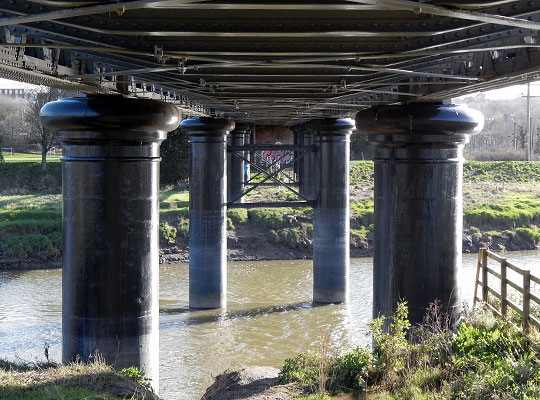Taw bridge
Taw bridge


















The north Devon town of Barnstaple eventually became the point of convergence for five railways, connecting it to Exeter (1854), Bideford (1855), Taunton (1873), Ilfracombe (1874) and Lynton (1898). Much of this network came under the control of the London & South Western Railway, with the main junction station sited on the south side of the River Taw; however the Devon & Somerset’s (D&S) branch from Taunton had a separate terminus on Victoria Road.
Early in 1885, the local Council considered two proposals for a link which would allow trains from Bideford and Torrington to reach Bristol via the D&S. Numerous objections were voiced to a scheme promoted by the Great Western (GWR), not least being the visual impact of a bridge over the Taw just south of the town and its likely interference pleasure craft. But the Council’s view was disregarded and the scheme was granted Parliamentary approval in April 1885. Work on its construction got underway in December.
Costing more than £25,000, the ‘loop line’ was 1½ miles in length, featuring seven masonry bridges and an alignment close to semi-circular. Contracted to build it were Messrs Meakin, Deane and Davis who, during the peak period, had 360 men on site, some of the work taking place overnight.
The river was crossed by an open lattice girder bridge supported by piers comprising pairs of concrete-filled cylinders, 5 feet in diameter, the latter being provided by the contractor. The Devon & Somerset made direct arrangements with E Finch and Co from Chepstow to supply the superstructure whilst W C Rafarel from the Barnstaple Foundry took responsibility for the ornamental pilasters, as well as riveting the structure together.
Although the abutments are brick-built, granite was used for the copings and bearings for the girders. Built in wrought iron, the structure is 122 yards long, comprising two spans of 89 feet, two of 56 feet and a fifth of 75 feet; this arrangement was adopted to address the Council’s concerns about the potential impact on navigation.
On 7th May 1887, Colonel Rich subjected the bridge to severe testing when he inspected it for the Board of Trade, complimenting the contractors for the manner in which the work had been undertaken. Three coupled engines, each weighing 40 tonnes, were left to stand over two of the piers for almost an hour with no appreciable deflection.
The line opened to traffic on 1st June and a new curve was installed at its north end in 1905 allowing trains to pass between the L&SWR and GWR systems without the need to reverse at Victoria Road. The Exeter branch was closed on 3rd October 1966, but goods services continued to visit Victoria Road – via the loop – until 5th March 1970.
The Taw bridge now carries a footpath and cycle route.







